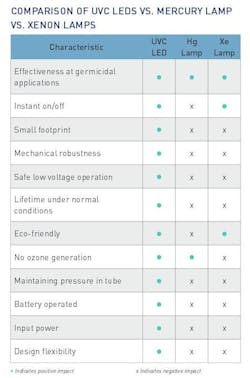
Late last year, Laser Focus World's sister publication BioOptics World reported that according to BCC Research, "The global market for ultraviolet (UV) disinfection equipment was valued at $790 million in 2010 and is expected to reach $1.1 billion by 2013." Finally, the amazing benefits of light are being harnessed in everyday applications that improve health and the environment while reducing energy consumption and limiting the use of harmful chemicals.
The BCC Research report points out, however, that although UV light disinfection for air, water, and surfaces has been practiced for more than 30 years, it has only achieved a signficant share of the disinfection market in the last decade. Why? I couldn't find a definitive answer online, but much of the delay probably has to do with increased research on the topic of UV disinfection and proof that it effectively kills viruses, pathogens, and even bed bugs, lice, and dust mites. Not to mention that lamp and LED prices continue to drop as performance improves.
An excellent application note from UV LED manufacturer Crystal IS (Green Island, NY; see http://www.cisuvc.com/content/application-notes/files/CrystalIS-AS01-UVC_Disinfection-012214.pdf)—although no doubt biased in favor of the LED option—dives into the differences between UV LEDs and traditional UV lamps (see chart below). The app note describes how the Crystal IS UV LEDs have concentrated output in the 255-275 nm UVC range--one of the narrower bands with a shorter wavelength than UVA and UVB, but a bit longer than the EUV or extreme ultraviolet region. While these LEDs can reach power levels of about 1-3 W, the prices go up as the wavelength goes down into the UVC region. I did find a 1 W 280 nm UV LED for $166-$200 (see http://www.alibaba.com/product-detail/Factory-sale-purple-1w-high-power_1441162845.html).
Among the lamp options, xenon lamps reach hundreds of Watts but have a very broad spectrum that spans both UV and visible/near-IR regions. Mercury-xenon lamps have sharp peaks in the UV and visible regions, while deuterium lamps have concentrated, efficient emission in the 180-370 nm UV range. Unfortunately, as the chart above shows, lamps suffer from the age-old afflictions that are causing the lighting industry to move to LED options: Lamps are cheaper today (about $100 for xenon/mercury-xenon and $300-$400 for deuterium), but suffer from shorter lifetimes and may succumb to LED successes in reduced energy consumption and ruggedness.
Companies offering UV disinfection products include Xenex for surfaces (non-mercury pulsed xenon lamps), Trojan for water purification (lamps), Aquionics for water (lamps and LEDs), and at least 88 more in a ThomasNet search.
So just who is using UV disinfection? Hospitals are embracing the technology more and more, especially considering that certain Medicare payments are stopping for hospital stays caused by surgical site infections (SSIs), according to several sources. A video from Steris below shows one disinfection solution:
There are numerous other resources online and videos that explain the utility of UV disinfection. Most importantly, it eliminates the use of chemical disinfectants and potentially halts the creation of even more dangerous bugs that fail to respond to antibiotic treatment. So next time you are in the hospital (for hopefully some minor procedure), you might want to find out in advance what type of disinfection the hospital is using and speak to someone influential so you can put in a good word about UV disinfection and help our photonics industry flourish!
About the Author

Gail Overton
Senior Editor (2004-2020)
Gail has more than 30 years of engineering, marketing, product management, and editorial experience in the photonics and optical communications industry. Before joining the staff at Laser Focus World in 2004, she held many product management and product marketing roles in the fiber-optics industry, most notably at Hughes (El Segundo, CA), GTE Labs (Waltham, MA), Corning (Corning, NY), Photon Kinetics (Beaverton, OR), and Newport Corporation (Irvine, CA). During her marketing career, Gail published articles in WDM Solutions and Sensors magazine and traveled internationally to conduct product and sales training. Gail received her BS degree in physics, with an emphasis in optics, from San Diego State University in San Diego, CA in May 1986.
